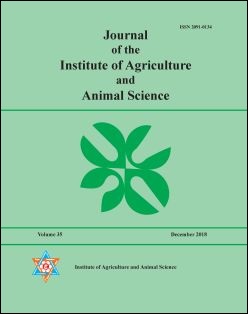Grain Yield and Agro-Climatic Indices of Rice Cultivars Transplanted in Different Dates in Mid-Western Tarai, Nepal
DOI:
https://doi.org/10.3126/jiaas.v36i1.48388Keywords:
GDD, Grain yield, rice, phenology, yield attributesAbstract
An experiment was conducted to assess the productivity and agro-climatic indices of different rice cultivars under staggered transplanting dates in farmers’ field at Lamahi, Dang during May to November 2018. The experiment was laid in a two factorial randomized complete block design with 9 treatments and 3 replications. Two factors included were: three rice cultivars; Arise-6444, Sarju-52, and Sukkha-3, and three transplanting dates; 19th June, 29th June, and 9th July. Phenological observation and yield attributing characters were recorded and statistical analysis was done. Cultivars under different transplanting dates showed significant variation in yield, yield attributes, and agro-climatic indices, individually and in interaction. Variety Arise-6444 attained early booting, panicle initiation, heading and flowering followed by Sukkha-3 and Sarju-52, respectively. Cultivar Arise-6444 showed the highest panicle weight (4.84g), effective tillers m-2 (242), grains panicle-1 (201) and grain yield (9213 kg ha-1). Early transplanting brought the phenological stages late as compared to mid and late transplanting. Cumulative GDD and PTI were significantly higher in Sarju-52 being 2066 and 15.90, respectively, whereas Arise-6444 showed the highest HUE (4.702). Irrespective of transplanting dates, early transplanting exhibited the highest GDD (2150.76) and PTI (16.36). Early transplanting of Sarju-52 showed the highest GDD (2211) while the highest PTI (16.59) was recorded in early transplanting of Arise-6444. Thus, varieties having high HUE should be planted early for better yield and to cope with the adverse effect of climate change.

